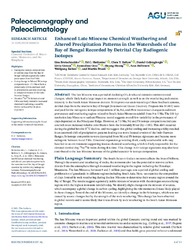Enhanced Late Miocene Chemical Weathering and Altered Precipitation Patterns in the Watersheds of the Bay of Bengal Recorded by Detrital Clay Radiogenic Isotopes
DOI: https://doi.org/10.1029/2021PA004252
Persistent URL: http://resolver.sub.uni-goettingen.de/purl?gldocs-11858/9768
Persistent URL: http://resolver.sub.uni-goettingen.de/purl?gldocs-11858/9768
Bretschneider, Lisa; Hathorne, Ed C.; Bolton, Clara T.; Gebregiorgis, Daniel; Giosan, Liviu; Gray, Emmeline; Huang, Huang; Holbourn, Ann; Kuhnt, Wolfgang; Frank, Martin, 2021: Enhanced Late Miocene Chemical Weathering and Altered Precipitation Patterns in the Watersheds of the Bay of Bengal Recorded by Detrital Clay Radiogenic Isotopes. In: Paleoceanography and Paleoclimatology, Band 36, 9, DOI: 10.1029/2021PA004252.
 |
Dokument öffnen: |
The late Miocene was a period of declining CO2 levels and extensive environmental changes, which likely had a large impact on monsoon strength as well as on the weathering and erosion intensity in the South Asian Monsoon domain. To improve our understanding of these feedback systems, detrital clays from the southern Bay of Bengal (International Ocean Discovery Program Site U1443) were analyzed for the radiogenic isotope compositions of Sr, Nd, and Pb to reconstruct changes in sediment provenance and weathering regime related to South Asian Monsoon rainfall from 9 to 5 Ma. The 100 kyr resolution late Miocene to earliest Pliocene record suggests overall low variability in the provenance of clays deposited on the Ninetyeast Ridge. However, at 7.3 Ma, Nd and Pb isotope compositions indicate a switch to an increased relative contribution from the Irrawaddy River (by ∼10%). This shift occurred during the global benthic δ13C decline, and we suggest that global cooling and increasing aridity resulted in an eastward shift of precipitation patterns leading to a more focused erosion of the Indo‐Burman Ranges. Sr isotope compositions were decoupled from Nd and Pb isotope signatures and became more radiogenic between 6 and 5 Ma. Grassland expansion generating thick, easily weatherable soils may have led to an environment supporting intense chemical weathering, which is likely responsible for the elevated detrital clay 87Sr/86Sr ratios during this time. This change in Sr isotope signatures may also have contributed to the late Miocene increase of the global seawater Sr isotope composition. Plain Language Summary:
The South Asian or Indian monsoon affects the lives of billions. Through the erosion and weathering of rocks, the monsoon also has the potential to remove carbon dioxide from the atmosphere through increased weathering in the region including the Himalaya Mountains. The late Miocene, between 9 and 5 million years ago, was a period of global cooling and proliferation of grasslands in different regions including South Asia. Here, we examine the composition of clays formed by rock weathering during the late Miocene to determine their source region around the Bay of Bengal. The results suggest a generally stable mixture of sources with the strongest sources being regions with the highest monsoon rainfall today. We identify slight changes in the mixture of sources, which accompany a global change in carbon cycling, highlighting the role monsoon climate likely played in these changes. Toward the end of the Miocene, we identify a change in the Sr isotopes, which was not caused by source changes but by the strength of the rock weathering. This change has been observed in global records and it seems likely that it was driven by rock weathering in the South Asian Monsoon region. Highlights:
Radiogenic isotope compositions of detrital clays from the Bay of Bengal indicate a generally stable provenance from 9 to 5 Ma.
A step change in Nd and Pb isotope compositions at ∼7.3 Ma reflects a climatically driven eastward shift in precipitation patterns resulting in enhanced erosion of the Indo‐Burman Ranges.
Elevated 87Sr/86Sr between 6 and 5 Ma was likely related to increased chemical weathering caused by thicker soils and by C4 plant expansion.
Statistik:
ZugriffsstatistikSammlung:
This is an open access article under the terms of the Creative Commons Attribution‐NonCommercial‐NoDerivs License, which permits use and distribution in any medium, provided the original work is properly cited, the use is non‐commercial and no modifications or adaptations are made.

